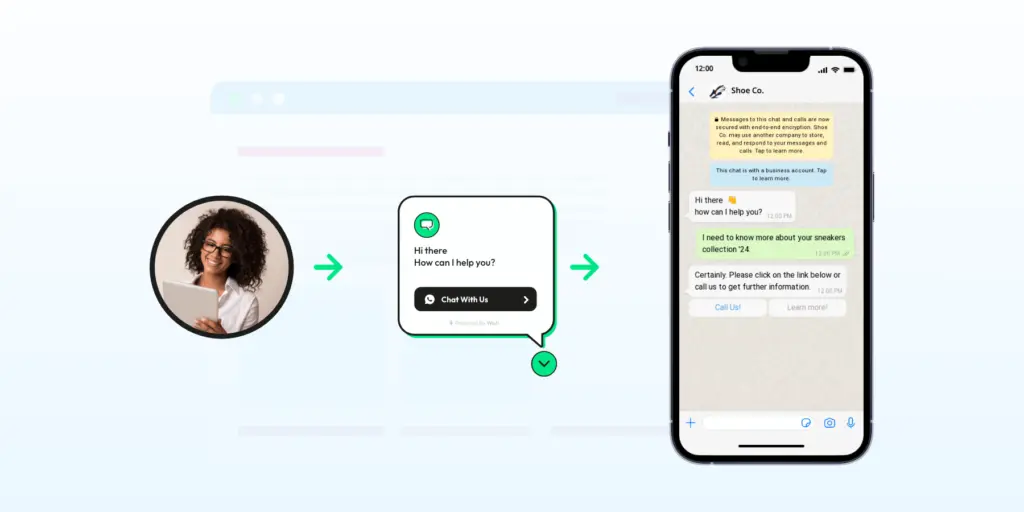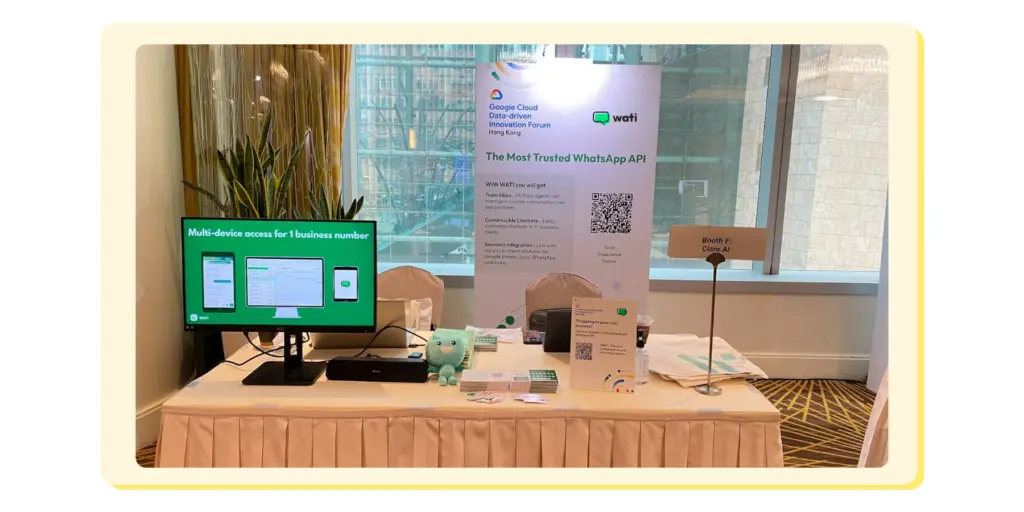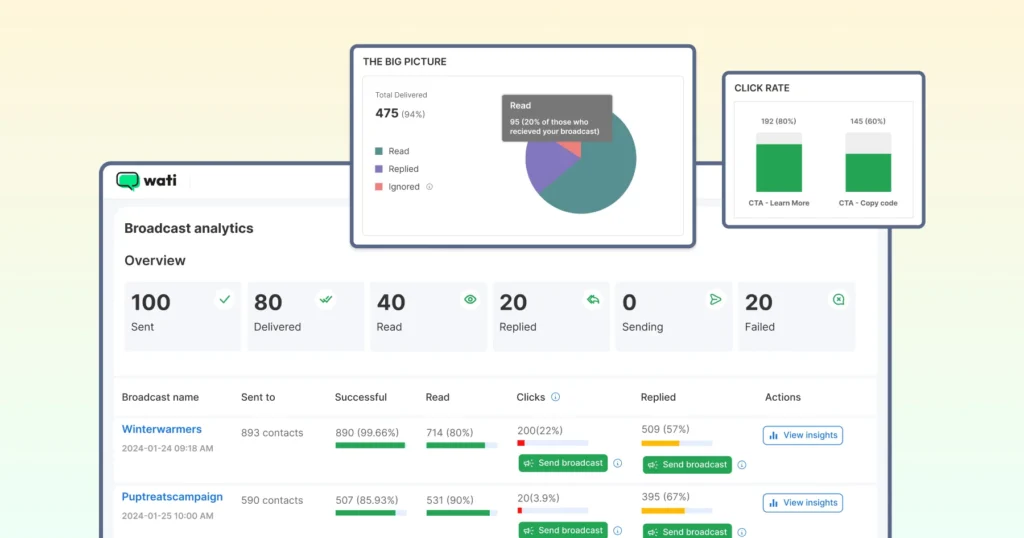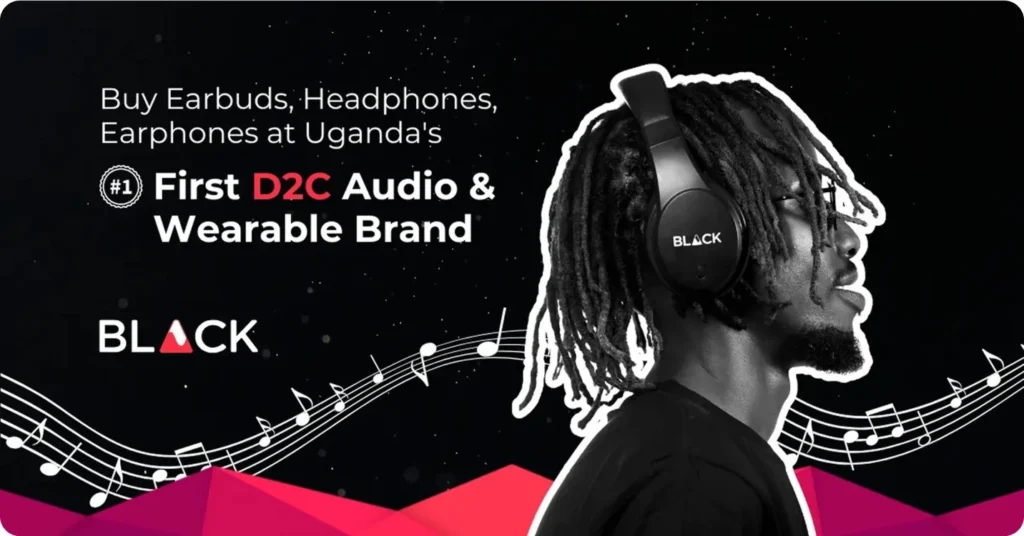
Complete WhatsApp Marketing Guide for Businesses
Written by:
 Ashwin
|
on:
July 9, 2025
|
Last updated on:
October 17, 2025
|
Fact Checked by :
Ashwin
|
on:
July 9, 2025
|
Last updated on:
October 17, 2025
|
Fact Checked by :
 Namitha
|
According to: Editorial Policies
Namitha
|
According to: Editorial Policies
Too Long? Read This First
- WhatsApp marketing helps businesses build real connections through direct conversations, leading to higher engagement than email or SMS.
- WhatsApp marketing also helps increase conversions, strengthen customer relationships, and provide insights that improve overall performance.
- Wati helps you manage everything from awareness to retention in one place with tools like Click to WhatsApp ads, automation, payments, and detailed analytics.
- WhatsApp marketing is cost-effective, easy to scale, and privacy-first, with end-to-end encryption and CRM-friendly integrations for data-driven campaigns.
People may skip a few WhatsApp messages, but they rarely miss checking them. That’s why WhatsApp continues to see higher open and engagement rates than email, making it a strong channel for real conversations.
WhatsApp messages are personal, instant, and to the point, making it easier to turn followers into loyal customers. Whether it’s sending a product update broadcast, offering support, or following up on a lead, WhatsApp marketing helps brands build trust and stay connected with their audience.
In this guide, we’ll explore how to use WhatsApp marketing and what makes it one of the most preferred communication channels today.
What is WhatsApp Marketing?
WhatsApp marketing helps to connect with customers in a simple and personal way. Businesses share updates, promote products, and keep conversations moving forward.
There are two main ways to use WhatsApp for your business: the WhatsApp Business app and the WhatsApp Business API. The right choice depends on your goals, audience size, and the level of personalization you want in your communication.
The WhatsApp Business app is free and can be downloaded from the App Store or Google Play. The WhatsApp Business API, on the other hand, is available through Meta-authorized service providers such as Wati.
4 WhatsApp Marketing ROI Generating Strategies
Whether you run a small shop or a growing business, WhatsApp marketing helps you reach customers quickly and easily. It delivers strong results, reduces the need to juggle multiple channels, and makes execution simple and effective.
Here are four key benefits that show why WhatsApp marketing works so well for businesses today.
1. High User Engagement
WhatsApp is one of the most preferred messaging channels across the globe. People trust it for its data security, use it often, and are more likely to open and respond to messages they receive there.
This means a direct and reliable way for brands to reach their customers.
2. Improved Conversion Rates
Studies have shown that WhatsApp has a higher conversion rate than traditional marketing channels like SMS and email. That’s right, messages sent through WhatsApp have a 98% open rate and an average response time of 90 seconds.
Conversations on WhatsApp often lead to quicker decisions and higher conversions. Since messages are personal and easy to respond to, customers are more likely to take action when they receive a message from a brand on WhatsApp.
When you share a limited-time offer directly with customers on WhatsApp, they are far more likely to see it than through email or other channels.
With just one click, they can connect with your brand, explore the offer, and take action immediately.
3. Increased Customer Satisfaction
Customers like it when communication feels personal and effortless. WhatsApp helps businesses to respond quickly, share updates, and offer support.

4. Drive Better Results with Analytics
WhatsApp marketing tools give you access to data that actually helps you improve. You can track message delivery, clicks, and customer responses to see what’s working and what isn’t.
These insights make it easier to fine-tune your campaigns, understand your audience better, and create WhatsApp template messages that get real results.
Doing WhatsApp Marketing the Right Way
Let’s look at a few best practices that can help you make the most of WhatsApp marketing.
Define your Target Audience
Before you begin any WhatsApp marketing campaign, take time to understand who you want to reach. Knowing your audience helps you craft messages that feel personal and relevant.
When you understand your audience well, you can craft campaigns and messages that truly resonate with them. This helps you maintain stronger engagement and turn everyday conversations into meaningful results.
Provide Value
To make your WhatsApp marketing more effective, share messages that genuinely interest your audience. Lead with a special offer or an exclusive update that gives them a reason to engage.
Keep the message short, clear, and focused so it feels natural and worth their time.

When people see real value in what you share, they are more likely to engage, trust your brand, and look forward to hearing from you again. The goal is simple: make every message worth opening.
Personalize Messages
If you want your messages to stand out, make them feel personal and genuine. People are more likely to respond when a message feels like it’s written just for them.
Use their name, remember their preferences, and speak to their interests.
How to Launch and Manage WhatsApp Campaigns with Wati?
A strong WhatsApp marketing strategy guides your customers through every stage of their journey, starting with awareness, then moving through interest, consideration, conversion, and finally retention.
By mapping this journey, you can identify key moments where WhatsApp can help you engage, nurture, and convert your audience more effectively.
Now, let’s look at how Wati supports you at each stage of this process.
1. Awareness: Capturing Attention
To attract potential customers, you need to make it easy for them to start a conversation with your business.

Adding a WhatsApp button to your website can help capture attention and drive more conversations by allowing users to contact you instantly.
I. Launching Click-to-WhatsApp Ads
For the awareness stage, you can use platforms like Instagram and Facebook to attract new leads through Click to WhatsApp ads.
When someone taps on your ad, they’re taken straight to a WhatsApp chat with your business. There’s no waiting or long forms to fill out.
II. Spread the Word with WhatsApp Links on All Platforms
Another way to attract customer conversations to your business is by using a WhatsApp link.
It’s a short URL that opens a direct chat with your WhatsApp Business account when someone clicks on it. You can create one easily with Wati’s free WhatsApp Link Generator.

You can add the link to your social media profiles, posts, emails, or even your website. Sharing it across different platforms makes it easy for anyone to start a conversation with your brand.
III. Drive Engagement with WhatsApp QR Codes
Wati lets you create a unique QR code that connects directly to your WhatsApp Business account. When customers scan it with their phone camera, they’re instantly taken to a chat with your business.
Where to use WhatsApp QR Codes?
- Product packaging & receipts: Encourage post-purchase inquiries or support requests.
- Storefronts & events: Let walk-in customers reach you with a quick scan.

- Social media & print ads: Turn offline audiences into WhatsApp leads instantly.
IV. Convert Instagram DMs into WhatsApp Leads
With Wati’s Instagram DM & Facebook Messenger automation, you can turn Instagram conversations into WhatsApp leads without any manual effort.
When someone messages your business on Instagram, Wati automatically captures their contact details and adds them to your WhatsApp list. This lets you move the chat to WhatsApp, where engagement is higher and conversations feel more personal.
2. Interest: Engaging Potential Customers
Once you’ve captured attention, the next step is to keep potential customers engaged. You can send customized messages and WhatsApp offers to engage potential customers, using templates and tools to deliver direct, personalized communication.
I. Broadcast Promotional Messages
Once you’ve captured attention, the next step is to keep your audience interested. WhatsApp Broadcasts make it easy to send messages to multiple people at once.
Just make sure your message templates follow WhatsApp’s Business Messaging Policy to keep everything compliant.
3. Consideration: Nurturing Leads
Not every potential customer will buy right away. During this stage, your goal is to keep the conversation going and build trust.
Share helpful updates, answer questions, and remind leads about products they’ve shown interest in. Automated messages and follow-ups can help you stay consistent without being intrusive.
You can also segment your audience to send personalized offers or product recommendations that cater to their specific needs.
I. Qualify Leads Using WhatsApp Chatbots
After you’ve reconnected with a lead, the next step is to understand how close they are to making a purchase.
WhatsApp chatbots make this easy by guiding users through conversations that ask the right questions and automatically collect key details.
For example, a chatbot can ask about their preferred product, budget range, or whether they’re buying for personal or business use. Based on their answers, you can group leads, send tailored follow-ups, or pass them directly to the sales team.
II. Showcase Your Offerings with WhatsApp Product Catalogs
A WhatsApp Product Catalog makes shopping easier for your customers by letting them explore your products or services directly in chat. There is no need to send them to a website because everything they need is right there.
Why use WhatsApp Product Catalogs
- Better browsing experience: Customers can see product images, details, and prices without leaving WhatsApp.
- Faster decisions: All the information is in one place, so they can decide quicker.
- Direct communication: Customers can ask questions and buy instantly within the chat.
4. Conversion: Turning Interest into Sales
To turn interest into sales, make the buying process as simple as possible.
Features such as chat buttons and quick replies help customers move through the buying process faster and with less effort. In regions where it is supported, in-chat payments make checkout even more convenient by allowing users to pay directly within WhatsApp.
I. Make Messaging a Breeze with Quick Reply Buttons and Calls to Action
Call-to-Action (CTA) Buttons: These help customers take the next step with a single tap. Buttons like “Buy Now” or “Register Here” make it easy to guide users toward key actions and boost conversions.
Quick Replies: These allow customers to respond instantly without typing. For example, if someone asks about gym membership options, your chatbot can display buttons labeled “Basic,” “Standard,” or “Premium.” The user simply taps their choice to continue the chat.
II. Make Buying Effortless with WhatsApp Payments
When a customer decides to make a purchase, they can complete the entire transaction right within the chat, without needing to switch apps or open a website.
By integrating WhatsApp Pay, you offer customers a quick and secure way to pay. It shortens the shopping experience smooth and convenient.
III. Boost Ad Performance with Conversion Tracking on WhatsApp
You’re not just closing sales; you’re also learning from them. By linking your WhatsApp Business account with Meta Business Manager, you can send conversion data back to Meta and understand what’s driving results.
Why does this matter?
- Meta identifies which ads lead to real actions, such as purchases or sign-ups through WhatsApp, and adjusts targeting accordingly.
- Better targeting leads to improved performance and reduced waste on ad spends.
- Every tracked conversation and conversion helps your future campaigns perform even better.
This integration keeps your funnel connected from click to chat to conversion, helping you measure and improve results more effectively.
5. Retention: Keeping Customers Engaged
A WhatsApp chatbot helps your business stay available to customers around the clock. It can answer questions, share information, and provide support, even when your team is offline.
The chatbot can also make personalized recommendations, guide customers to the right products, and even complete purchases on its own.
With Wati’s no-code chatbot builder, you can set up a WhatsApp chatbot quickly and start creating smooth, always-on conversations that keep customers coming back.
6. Tracking Performance and Measuring ROI
Once your campaigns are running, it’s important to track how they’re performing. Analytics help you understand what’s working, what needs improvement, and how customers are responding.

You can monitor key metrics like message delivery, click-through rates, replies, and ad-to-chat conversions. This data helps you fine-tune your approach and improve results over time.
WhatsApp Marketing Examples That We Love
Now, let’s look at some brands that are doing WhatsApp marketing really well.
Blacklyf
Blacklyf, Uganda’s first direct-to-consumer audio and wearable electronics brand, turned to WhatsApp as its main channel for customer engagement and support.
With its commitment to winning customer trust through warranty policies and responsive service, Blacklyf has made WhatsApp its primary channel for customer acquisition and support, aligning with local preferences for communication and trust-building.

Using Wati’s Click-to-WhatsApp solution, the brand transitioned from a website-first approach to direct, real-time conversations.
Results
- 3x higher conversion rate
- 21% increase in lead volume
- 60% lower acquisition cost
Habuild
Habuild is an online wellness platform focused on yoga and habit building. Since many of its users prefer WhatsApp over other apps, the platform made WhatsApp its main channel to stay connected with customers around the clock.
With Wati, Habuild used chatbots and automated communication flows to engage users and build a stronger sense of community.
Results:
Grew from 400 to 3.8 lakh users in just 4 years
Scaled to over 3.1 lakh customers with Wati’s chatbots and automations
Ready to Revamp Your WhatsApp Marketing Strategy?
Take the first step toward smarter, more personal customer conversations with Wati. Try it for free today and see how WhatsApp can transform the way your business connects and grows.
Frequently Asked Questions
No, WhatsApp has strict guidelines to prevent spam. You can only send promotional content to users who have provided explicit consent to receive messages from your business. Violating this policy could result in your account being banned.
The WhatsApp Business API allows for integrating WhatsApp messaging with your existing business systems. You can automate messages, send notifications like delivery information or appointment reminders, provide customer support, and engage in large-scale two-way conversations.
While WhatsApp doesn’t offer built-in audience segmentation features, you can manage this by organizing contacts into lists based on criteria like interests, purchase history, location, etc. Customizing your communication for each group can make your marketing efforts more targeted and effective.
WhatsApp doesn’t provide comprehensive analytics for your marketing campaigns. However, using UTM parameters with URLs, integrating third-party tools, or leveraging the capabilities of the WhatsApp Business API indirectly can help you track campaign performance, customer engagement, and other valuable metrics.



Latest Comments